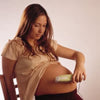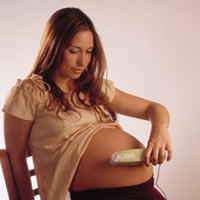
Fetal Doppler Info
The Use of Dopplers in Fetal Monitoring

It is becoming increasingly recognised by the medical profession that it can be very beneficial for pregnant women to use a fetal doppler at home in between visits to their GP or hospital. This is particularly the case where mothers are anxious perhaps because they have previously had a difficult pregnancy or a miscarriage.
It has been found that when such a pregnant women buys or rents one of the current range of reasonably priced lightweight hand held dopplers her confidence and wellbeing increases.
Confused by the different types and models of dopplers?
If you have been looking at various websites and thinking of buying or renting a Doppler, you may well have become confused by the seemingly many different options available. However, in general there are two different types of real fetal dopplers. Those so-called 'pre-natal listeners' such as Bebe Sounds that simply amplify sounds within the abdomen are not dopplers. The two types are 'sound only' and 'digital' fetal dopplers. The sound only allows you to hear the baby's heartbeat. The digital fetal Doppler will also give you the sound but in addition it gives a digital display of the baby's heartbeats per minute.
How Fetal Dopplers Work

Fetal doppler technology is based on the Doppler shift principle. This theory was first discovered by Christian Doppler an Austrian physicist in 1842. Doppler discovered that sound waves from a moving source would be compressed or expanded, or that the frequency would change.
Dopplers work on the principle of listening to reflections of small, high frequency sound waves (ultrasound). These ultrasound waves are generated by microscopic vibrations of pizeoelectric crystals. When the waves are reflected from moving objects, such as a foetal heart the frequency changes slightly. It is this change that is analysed by the electronics of the doppler and converted into a sound that you can hear or a digital display of the heart rate.
Helpful Doppler Tips
- Use a generous amount of Ultrasound gel.
- Re-apply gel if you have been using the doppler for some time as it dries out relatively quickly.
- A full bladder often helps, especially in early pregnancy.
- Place the doppler probe low down on your abdomen - near your bikini line.
- Tilt the doppler probe downwards towards the pubic bone.
- Move the doppler probe VERY SLOWLY until you pick up the heartbeat.
For best results keep the transducer handle as still as possible to maintain a steady signal It is common for the doppler to pick up the heartbeat in two different places - do not be alarmed, this is the same heartbeat. As your pregnancy progresses gradually place the probe higher up on your abdomen.
The fetal heart sounds like the hoofbeats of a galloping horse. If you hear a whooshing sound this is the sound of the placenta.
The fetal heart rate is usually between 140 and 160 beats per minute, approximately twice that of the mother's heart rate. But the heart rate varies depending upon the time of day and the amount of the baby's activity.
You can usually hear the baby's heart beat from about twelve weeks, sometimes you can hear it as early as ten weeks.
It can take a bit of practice before you can quickly locate the baby's heart beat. Even midwives sometimes find it difficult to locate the heart beat. If you are having difficulty in picking up the baby's heart beat, there could be a number of reasons for this: poor quality of signal due to the handle position, foetal position, maternal position or foetal or maternal movement. Too little gel or noise or other interference can also affect the monitor's ability to pick up the heartbeat.
Remember that in the early stages of pregnancy the foetus is still quite small (approx 5cm at 12 weeks) and so locating the heartbeat is not always easy.
Doppler Safety
Ultrasound has been used as a diagnostic tool in pregnancy for well over twenty five years. It has long been considered to be one of the safest tools available for obtaining information about the unborn baby. It has been estimated that there are at least five million in use every single day.
Global studies and tests conducted by government agencies, research institutes and manufacturers have not shown any adverse side effects of diagnostic ultrasound. In 2002 the British Medical Ultrasound Society (BMUS) issued a statement confirming that there has never been any evidence of harm resulting from the use of ultrasound in pregnancy.
Please note that home use of these devices should not be used as a substitute for professional medical care. In you are in anyway concerned about your baby you should seek professional medical advice.- Featured
- Best selling
- Alphabetically, A-Z
- Alphabetically, Z-A
- Price, low to high
- Price, high to low
- Date, old to new
- Date, new to old
No products found




